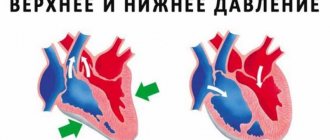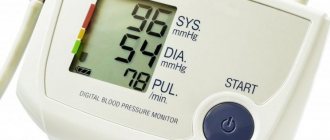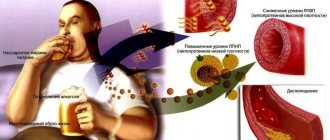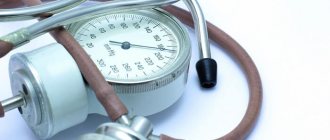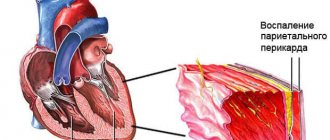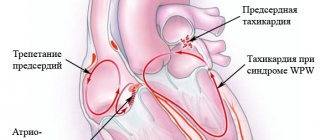Today, almost every person has encountered the problem of high blood pressure. What is high low blood pressure, the causes and treatment of which every person must know in order to prevent complications of the disease.
First of all, you should understand what lower pressure is. Lower pressure is diastolic pressure, which characterizes the condition of the main arteries, the flexibility of their walls and the width of the lumen.
What is the normal lower pressure?
Diastolic pressure readings of 65-80 mm Hg are considered normal when the arterial walls are excited. As they narrow, they lose their elasticity and internal pressure begins to increase. With age, a slight deviation from standard lower pressure values is possible. This happens due to the aging of the body and wear and tear of blood vessels. The human body has no noticeable problems in the functioning of the heart and blood vessels.
Systolic (upper) pressure (110-140 mm Hg) and diastolic pressure can increase independently of each other. Experts call such cases arterial hypertension.
Video
Causes
The factors that provoke a drop in lower blood pressure are very diverse, but more often diastolic hypertension occurs against the background of existing other diseases. So, if a person has increased renal pressure to 120 mm Hg. Art. – this indicates the presence of any disorders in the body. An increase in lower blood pressure usually occurs due to:
- being overweight;
- genetic predisposition;
- low physical activity;
- unstable psycho-emotional state;
- eating a lot of salt;
- bad habits (smoking, drinking alcohol, drug addiction).
In addition to the general factors listed above, there are other causes of high lower pressure. A persistent increase in diastolic reading may indicate the presence of:
- kidney diseases;
- hormonal imbalance;
- thyroid dysfunction;
- neoplasms in the adrenal glands, on the pituitary gland;
- pathologies of the cardiovascular system.
Increased lower pressure with normal upper
An increase in diastolic blood pressure indicates a high resistance of the vascular walls and their constant spasm. If arteries and veins are constantly narrowed, blood flow slows down, causing organs and tissues to receive less oxygen and nutrients. Thus, isolated diastolic pressure leads to disruption of the functioning of the entire body. Reasons for this phenomenon:
- kidney pathologies, including congenital abnormal structure of the organ, chronic glomerulonephritis, etc. (this organ is involved in the regulation of blood pressure, and an increase in the latter may mean a narrowing of the renal artery, which reduces the volume of blood entering the kidneys);
- diseases of the pituitary gland, adrenal glands;
- heart diseases (defects, tumors);
- pathologies of the thyroid gland;
- spinal hernia;
- hormonal imbalance.
Reasons for increasing lower blood pressure simultaneously with upper blood pressure
If the lower blood pressure is elevated along with the upper reading (for example, pressure 130 per 100 mm Hg), the patient may have heart valve defects, aortas, arrhythmia, and excessive activity of the adrenal glands. The simultaneous increase in both blood pressure numbers may be due to:
- hyperthyroidism (increased production of thyroid hormones);
- old age (in old age, the upper blood pressure increases due to disruptions in the heart, and the lower – due to sagging blood vessels);
- a combination of different diseases (for example, a patient simultaneously has vascular disease and aortic valve disease).
Causes of high lower blood pressure in women
An increase in diastolic indicator is associated with various factors. In about a quarter of women, the causes of hypertension are due to excess weight, low physical activity, and frequent stress. In some cases, lower blood pressure is high due to endocrine pathologies or kidney diseases. The diastolic indicator may increase in both elderly patients and young girls, while the reasons for the deviation may remain unidentified (as a rule, if the patient has no concomitant diseases).
High lower pressure - what does it mean?
Lower (diastolic) pressure is also called kidney pressure, because it is its level that determines the stable functioning of the kidneys. An increase in lower pressure indicates dysfunction of the body; due to its changes, kidney function worsens.
In situations where lower pressure values increase above 90 mmHg. and do not decrease over a long time, the situation is a pathology, because Blood circulation in the body becomes worse, the structure of blood vessels changes, the heart, kidneys, and brain are at risk, and myocardial infarction may occur.
But when the lower pressure changes a little, then there is nothing terrible, because... this is provoked by physical tension, emotional, and also stressful situations.
What does high diastolic pressure mean?
Diastolic pressure determines the functioning of the renal apparatus. Consequently, increased lower blood pressure indicates the development of pathological changes and renal dysfunction in the patient’s body. If timely and competent measures are not taken, the disease will progress, affecting other internal organs (heart, blood vessels, brain). Very high lower pressure is a provoking factor for disruption of blood circulation and microcirculation processes, and the development of a heart attack.
However, according to doctors, if diastolic pressure is only a few notches higher than normal and appears periodically, serious therapy is not required, since this condition can be caused by stressful situations, psycho-emotional shocks, mental or physical fatigue.
Stages of increased blood pressure
According to severity, the following degrees of blood pressure increase are distinguished:
- Mild – pressure readings are 90-100 mm Hg.
- Average – indicators at the level of 100-110 mm Hg.
- Severe – readings over 110 mm Hg.
The stages of increased blood pressure are divided into the following (“or” means that one of the blood pressure indicators increases):
| Stage | Upper pressure | Lower pressure | |
| normal | 120 | on | 180 |
| elevated normal blood pressure | 120 -139 | or | 80 -89 |
| First stage of hypertension | 140 -159 | or | 90-99 |
| Second stage of hypertension | 160 and more | or | 100 or more |
| Hypertensive crisis | > 180 | or | > 110 |
As can be seen from the table, depending on the relationship with systolic pressure, it happens:
- Diastolic hypertension - when one lower pressure increases.
- Systolo-diastolic hypertension - two indicators increase simultaneously.
Causes of the primary form of ISAH
The primary form is extremely rare in practice. These are isolated cases, described in the literature; only 10% of clinical situations occur in the primary form of the disease.
As the name suggests, pathology with increased upper pressure (so-called essential hypertension) has a pronounced vascular origin and occurs in three cases:
- Congestive heart failure with the development of cardiac arrhythmias. The more pronounced the condition, the more elevated the upper pressure, while the lower reading remains normal.
- Stroke in the recent past. There is an adaptive mechanism. We can talk about either a temporary decrease in blood pressure due to an emergency condition or isolated hypertension.
Patients with ISAH need to be monitored more carefully; the high probability of relapse does not allow either doctors or the patient to relax.
- Previous heart attack. In the period up to 6 months (early rehabilitation), you need to carefully monitor the patient's health. Repeated cases of ischemia of the heart muscle are possible. Since isolated systolic hypertension often accompanies patients, problems are likely.
Hereditary factors also play a significant role. Most relevant sources directly indicate this. There is a correlation, and the likelihood of developing isolated systolic hypertension is higher, the more hypertensive people there are in the family.
Even the presence of one relative is enough to increase the risk of pathology in the phenotype of future offspring by almost 50%.
Of course, this is not a verdict. The situation can be corrected if you carefully follow the rules of prevention and do not play with your own life and health.
Age is also given some importance. As the body ages, phenomena that increase blood pressure increase:
- Decreased receptive function of special cells of blood vessels and heart.
- Impaired glomerular filtration.
- A decrease in general blood flow and local renal, cerebral and muscular hemodynamics due to a decrease in the intensity of cardiac output, all this is the cause of increased upper pressure in the elderly.
What are the causes of high blood pressure?
Most often, blood pressure increases in people who have already been diagnosed with vascular problems. Patients who are treated for endocrine diseases should also monitor heart function, because... During therapy, drugs that negatively affect cardiac diastole are used. As a result, various pathologies may develop.
Other factors for high lower blood pressure may include:
- Food containing a lot of fat and salt. If you eat a lot of foods that are saturated with animal fat, then cholesterol plaques are deposited on the walls of blood vessels. As a result of this accumulation, the lumen of blood vessels decreases. Salt, in turn, retains fluid in the body, which creates additional stress on the arteries (they lose their elasticity and wear out faster).
- Nicotine and alcohol. Almost all patients treated for high blood pressure have a nicotine addiction and drink alcohol. Nicotine narrows the lumen of blood vessels and, as a result, blood pressure increases. It is necessary to get rid of bad habits.
- Overweight. Excess weight increases the load on the heart, as a result the structure of blood vessels changes. In the future, it becomes more difficult to pump blood.
- Negative emotions, stress. The whole body weakens, incl. and heart, its work worsens.
- Inflammation. Inflammation of the kidneys is the most dangerous. When lower pressure rises constantly, kidney function deteriorates. When kidney inflammation occurs, increased blood pressure can trigger kidney failure.
In the case where a violation of diastole is clearly established, pressure should be measured regularly and the specifics should be taken into account: the patient’s well-being, time of measurement (morning, afternoon, evening), and use of medications.
Recommendations for certain groups of the population on how to measure blood pressure are presented below.
You can also learn how to measure blood pressure with mechanical and electronic tonometers.
| Age category | Pressure measurement |
| 15-50 years – no heart problems, normal weight | Every year during annual examinations. |
| 15-50 years – there are kidney problems | In case of exacerbation - daily; during remission - daily. |
| 15-50 years – cardiac dysfunction | In case of exacerbation - daily, after physical exercise. loads |
| People working physically | Every day in the evenings. |
| Over 50 years old with heart problems | Every day morning and evening. |
| Over 50 with kidney problems | Three times a day at equal intervals |
| Overweight people | Every day, regardless of how you feel. |
You need to know that timely measures to lower blood pressure prevent the occurrence of myocardial infarction and stroke. People over 60 years of age should carry antihypertensive medications with them.
Causes of secondary IDAH
Secondary isolated arterial hypertension occurs many times more often. There is some pathological process that causes a change in the nature of hemodynamics.
The immediate reasons for the development of IDAH in this case:
- Pregnancy. Patients during gestation suffer from sudden jumps in blood pressure. Various options for changes in blood pressure are possible: hypotension or hypertension of different types.
This is a relatively normal phenomenon that resolves on its own after delivery within 3-4 months.
It is advisable to visit a cardiologist all the time to stabilize the condition. This will protect the patient from unpleasant surprises.
- Tumor formations of the adrenal glands. The most common types are adenomas and malignant neoplasias. As a result of the development of the process, there is an increased production of corticosteroids, primarily cortisol, which has a pronounced hypertensive effect.
Another possibility is tumors and injuries to the anterior pituitary gland.
As a result, corticotropin is synthesized: a hormone that is responsible for stimulating the production of cortisol. Primary Itsenko-Cushing's disease with characteristic manifestations is formed.
- Pheochromocytoma. Separate conversation. It is a common tumor of the adrenal glands that stimulates the production of corticosteroids - this is the reason why low blood pressure is high. The pathology requires urgent treatment under the supervision of a whole group of doctors.
- Pathologies of the kidneys and excretory system. A heterogeneous group of diseases. Among them: pyelonephritis, nephritis, glomerulonephritis, nephropathies of various etiologies, acute and chronic renal failure.
As a result of disturbances in the filtering function, blood pressure increases, sometimes unevenly. Everything can end in malignant hypertension and death.
- Osteochondrosis of the cervical spine. Vertebrobasilar insufficiency. In a word - pathologies accompanied by circulatory disorders at the local level.
They provoke a decrease in trophism (nutrition) of special centers of the brain responsible for the normal regulation of the tone of blood vessels, hence the asymmetrical increase in blood pressure.
- Other endocrine diseases: thyrotoxicosis (increased concentration of thyroid hormones), decompensated diabetes mellitus, tumors of the pituitary gland and hypothalamus.
Factors increasing lower pressure with normal upper
Above we considered situations where the lower limit of pressure can increase, but the upper limit is normal. This situation is called isolated arterial hypertension. This condition can cause dysfunction of various organs. Factors for this condition may be:
- Kidney pathology, anomaly at birth, membranous-proliferative glomerulonephritis, etc. Kidney functioning is very dependent on lower pressure.
- Diseases of the pituitary gland and adrenal glands.
- Heart diseases.
- Pathological diseases of the prostate gland.
- Hormone imbalance.
- Spinal hernia.
Causes of pathology
Secondary form of ISAH
Secondary ISAH is a complication of a number of pathologies:
| Group of diseases | Specific diseases |
| Hereditary and congenital disorders | Coarctation (narrowing) of the aorta Patent ductus arteriosus Polycythemia (increased red blood cell count) |
| Cardiac and vascular disorders | Complete atrioventricular block (impaired heart contraction) Aortic valve insufficiency Atherosclerosis of the renal arteries Aortoarteritis (inflammation of the vascular lining) |
| Other violations | Anemia Fever Thyrotoxicosis (high level of thyroid activity) |
Primary form of ISAH
Primary, or essential, ISAH develops through the interaction of two or more risk factors (these risk factors are the same for any form of arterial hypertension):
- genetic defect;
- age-related changes in the vascular wall (decreased elasticity) and metabolic disorders (increased activity of pressure-stimulating hormones);
- atherosclerosis;
- smoking;
- excess weight with impaired fat metabolism;
- diabetes;
- female gender (incidence is twice as high).
Factors that increase lower pressure while simultaneously increasing upper pressure
A parallel increase in both pressure boundaries is called systolic-diastolic hypertension. This condition means that a person has: heart or aortic valve disease, heart rhythm disturbances, adrenal hyperactivity.
Factors for this condition may be:
- Hyperthyroidism (overactive prostate gland).
- Older age (upper pressure increases due to poor heart function, lower pressure increases due to wear and tear of the blood vessels).
- Diseases of the cardiovascular system.
Factors that simultaneously improve performance
High lower blood pressure in combination with simultaneously increased systolic blood pressure is a manifestation of systolic-diastolic hypertension. The following factors can provoke pathology:
- The advanced age of a person, due to wear and tear of blood vessels, cardiac dysfunction and other undesirable age-related changes;
- Cardiovascular pathologies;
- Hyperthyroidism.
A stable increase in two blood pressure indicators simultaneously may indicate the development of aortic and cardiac defects, adrenal hyperactivity, and heart rhythm disturbances. Therefore, with such a clinical picture, it is necessary to seek help from a specialist and undergo a comprehensive examination to make an accurate diagnosis. Identifying the causes of the disease.
Possible consequences
It is necessary to understand that an increase in blood pressure is a sign of an impending serious illness. The oncoming underlying disease leads to deterioration of hemodynamics in the heart and brain. This is because the arteries and blood vessels are kept under regular tension due to the decrease in pressure.
Even when the heart is calm, vascular tension does not decrease. This may result in the development of myocardial infarction and stroke. Delayed assistance can lead to death.
Why is this condition dangerous?
Is this kind of blood pressure dangerous at all? After all, the pulse rate is at a minimum level. No, it's not quite like that.
The smaller the gap between the lower and upper indicators, the more dangerous the condition. The heart simply does not have time to rest between ejections of blood.
This is fraught with the development of the following complications:
- Myocardial infarction. Can be extensive. It is characterized by acute death or necrosis of the muscular structures of the heart muscle.
Even with timely treatment, the vital function of the heart decreases: dead tissue is not restored, but is replaced by scar structures (read more about the process here).
The organ cannot function as before. This leads to disability.
- Stroke. Similar process. It is determined by acute necrosis of cerebral structures. Neurons die. In the worst case, a blood vessel in the brain ruptures (hemorrhagic stroke).
- Acute renal failure. It develops in almost 80% of cases if the condition is not stopped in time.
- Irreversible visual impairment.
- Chronic heart failure with prospective sudden arrest.
To prevent conditions, you need to see a doctor and undergo timely treatment.
Symptoms of high lower pressure
Arterial hypertension has no characteristic signs. In the case of isolated hypertension, there may be no symptoms at all, so nothing worries the person. Therefore, it is necessary to measure blood pressure with a tonometer if a person has complaints that make it difficult to determine the presence of high blood pressure.
Common symptoms of hypertension may include:
- The pain in the head is aching, throbbing, bursting. Predominant in the frontal and parietotemporal zones.
- Pain in the heart, accompanied by increased heartbeat, rapid pulse, and lack of air.
- Trembling in the body, weakness.
- Dizziness.
Diagnostics
It involves a complete examination of the patient by several specialists: a cardiologist, an endocrinologist, a nephrologist and a neurologist in the system.
An approximate list of diagnostic measures looks like this:
- Questioning the patient. It involves identifying subjective sensations. That is, the actual symptoms of the condition.
- Anamnesis collection. The factors of the presence of bad habits and somatic diseases are established.
- Measuring blood pressure levels on both arms with minor breaks.
- Daily Holter monitoring using an automatic tonometer.
- Electrocardiography. In the right hands it is highly informative.
- Encephalography.
- Study of hormone levels.
- Blood biochemistry, general analysis.
- Urine examination.
- Angiography or Dopplerography as necessary.
The final list of measures is determined by doctors; it can be either shorter or longer.
Non-drug ways to lower blood pressure
In situations where the increase in pressure is taken by surprise, the following tips should be followed:
- Take a horizontal position (lie down).
- Apply ice to your neck (through a cloth or towel).
- After a couple of minutes, remove the ice compress and massage your neck.
- Perform an acupuncture massage (from the hollow under the earlobe to the collarbone).
You should also apply recommendations that are longer in nature, but bring positive results:
- Losing weight. Reducing weight by 4-6 kg helps normalize blood pressure and eliminates the use of medications.
- Reduce your intake of salty foods. A person eats several times more salt than normal. Salt tends to retain fluid in the body.
- Physical activity. A sedentary lifestyle contributes to the development of hypertension. Constant physical activity helps lower blood pressure by several units.
- Products containing potassium and magnesium. These microelements have a positive effect on blood pressure. Cabbage, potatoes, banana, corn contain potassium. Nuts, beans and seafood contain magnesium.
What can you do at home?
By and large, nothing can be done at home. It will only get worse, since hypertension has an atypical hemodynamic character.
It is not possible to lower lower pressure using classical means; they affect both indicators. Urgent medical attention is needed.
It is recommended to call an ambulance and not engage in any amateur activity until it arrives. Is it dangerous.
- You need to take a horizontal position and move as little as possible so as not to aggravate an already difficult situation.
- You can take light sedatives based on herbal ingredients: motherwort, valerian, but not in the form of an alcohol tincture, but in tablets (1 pc.)
- Drinking emergency medications is strictly prohibited except in cases expressly discussed with a medical specialist at a preliminary appointment.
- It is necessary to regularly measure blood pressure levels and inform the arriving doctors.
All other measures are not recommended. It's unpredictable. It is not known how such an initiative might end.
It is possible to selectively lower lower blood pressure only with the help of doctors.
Drug treatment
The following groups of drugs are used to lower blood pressure:
- β-blockers - normalize blood pressure and control heart function. Medicines in this group reduce the heart's need for oxygen, which helps relax muscles. Toning the muscles stabilizes hemodynamic strength and lowers blood pressure to normal.
- Slow calcium channel blockers. Promote the production of renin, which is difficult to produce when kidney function is impaired. These drugs are suitable for the treatment of complex stages of hypertension or after myocardial infarction.
Long-term increased lower blood pressure is a problem that must be treated responsibly.
Doctors prescribe the following medications for treatment:
- Concor. A β-blocker, which lowers blood pressure, normalizes the pulse and heart rhythm. The active ingredients are bisoprolol and hemifumarate. Concor reduces myocardial oxygen demand and prevents the development of angina pectoris and myocardial infarction. The drug acts a few hours after use and has good absorption. The disadvantage is the development of withdrawal syndrome when abruptly stopping the use of the drug.
- Carvedilol. Belongs to the group of β-blockers that do not selectively block β-adrenergic receptors. It is used as a separate drug, sometimes in combination with BMCC, diuretics, ACE inhibitors, angiotensin II receptor blockers. It is well absorbed in the gastrointestinal tract and has normal bioavailability. The disadvantage is that Carvedilol is contraindicated for use in heart failure at the stage of decompensation.
- Verapamil. Effectively lowers blood pressure, prevents the occurrence of arrhythmia and coronary artery disease. Reduces the resistance of the vascular walls, reduces heart rate. Positively affects kidney function. Disadvantage: low bioavailability
Diuretics are of great importance in the treatment of high blood pressure, because. slow down the absorption of salt and fluid into the renal tubules. The use of diuretics helps remove excess fluid, relieve swelling, and normalizes sodium levels in the blood. Drugs in this group include:
- Hypothiazide. Effectively removes sodium, potassium and chlorine ions from the blood. The use of the medicine forces you to enrich your diet with potassium-containing foods. It should not be taken with potassium-sparing diuretics.
- Spironolactone. Has a lasting effect several days after use. Parallel use with antihypertensive and diuretics is possible. The deficiency manifests itself with prolonged use (for men – erection worsens, for women – the menstrual cycle is disrupted).
It is also important to follow a diet that is aimed at rehabilitating the body and protecting it from negative reactions to drugs.
Necessary:
- Eat more greens, vegetables, fresh fruits, dairy products.
- Reduce the amount of preserves and pickles.
- Reduce consumption of salty, fatty, fried foods.
- Get rid of bad habits (alcohol, nicotine).
- Eat food that is steamed or boiled.
- There is garlic.
- Drink herbal infusions, fruit drinks, juices, green tea (not strong), water.
Home treatments
Some people prefer to use herbal treatments. With the help of decoctions and infusions, a gentle reduction in blood pressure is achieved. But it is important to remember that this is not a separate method, but only an addition to the main therapy.
The following will help stabilize diastolic blood pressure:
- Motherwort. The grass is poured with boiling water and left for half an hour. Drink several times throughout the day.
- Valerian root. An infusion of them is consumed several spoons during the day after meals.
- Peony root. The raw materials are brewed in boiling water and kept in a water bath. Drink three times a day 10 minutes before meals.
- Rose hip. Its fruits are poured with boiling water and left for 10 hours. The infusion is diluted with boiled water before use and drunk like tea.
These plants have a lot of beneficial properties, but it is not recommended to use them without the knowledge of a doctor. Only he can choose the optimal method for lowering lower pressure.
Treating high blood pressure at home
The use of non-traditional methods of treatment must be carried out together with traditional ones. Before using folk remedies, you should consult a doctor.
- Tincture of cedar cones. Helps reduce high blood pressure. Pour 3 cones with 0.5 liters of vodka, add 15 ml of valerian tincture, 2 tbsp. l. Sugar and leave in a cool, dark place for two weeks. Then strain and refrigerate. Drink 15 ml before bed every day until symptoms disappear.
- Aronia tincture. In case of blood clots, taking this medicine is contraindicated. To prepare, you need to puree 250g of chokeberry, add 0.5 liters of hot water and cook for 5 minutes, then strain. Leave in a dark place for a week. The course of treatment is prescribed by the doctor.
Forecast
Arterial hypertension, when the upper pressure is high and the lower pressure is normal in 68%, is combined with diabetes, pathology of lipid metabolism and ischemic disease, which significantly increases the risk of developing vascular and cardiac complications.
75% of people in the older age group are diagnosed with increased blood pressure, of which 52–87% have ISAH. 84% of the population dies every year from vascular pathology due to a constant form of high blood pressure.
Treatment of hypertension reduces mortality by 17%, and the risk of fatal complications (sudden death, stroke, heart attack) by 32%.
There is no complete cure for the disease - hypertension requires constant, lifelong therapy, but its implementation is the key to extending the quality and duration of life.
Symptoms
Isolated systolic hypertension in half of the cases does not signal itself at first. They learn about it already when signs of disturbances in cerebral and cardiac blood flow appear.
Symptoms of ISAH when upper blood pressure is elevated are as follows:
- Headache.
- Discomfortable sensations in the heart area.
- Fatigue, mood swings, forgetfulness, which indicates insufficient blood supply to the brain.
- Deterioration of visual perception.
- Floaters before the eyes or darkening.
With very high upper blood pressure, more dangerous symptoms appear in the form of:
- Strong headache.
- Veil before the eyes.
- Nose bleed.
- Dizziness.
- Nausea.
Most hypertensive patients are unaware of their diagnosis, because often there are simply no symptoms. Over time, the condition only worsens and the person can no longer live at the same rhythm as before.
Treatment
Blood pressure normally does not require correction, but if it rises, it needs to be treated immediately .
There are a lot of modern medications, thanks to them it is possible to reduce high blood pressure.
How to lower the upper pressure without lowering the lower?
Pay attention to products that lower blood pressure
When blood pressure jumps, it is difficult to control it, especially for a working person who does not have time to measure indicators every 2 hours. Only a doctor can prescribe adequate treatment after examination. But how can you lower high upper pressure without lowering lower pressure, which is a sign of ISAH?
If blood pressure decreases from medications, hypertension can therefore be treated .
However, antihypertensive drugs alone are not always enough:
- Smoking and drinking alcohol should be a thing of the past.
- A diet is recommended . All harmful and fatty foods and salt are excluded from the diet. What to do? Eat more fortified foods.
- Do not give up light physical activity.
- Drink plenty of fluids, but do not overdo it.
- Take a walk in the fresh air.
- Engage in physical therapy , the exercises of which depend on the condition of the hypertensive patient.
- Adjusting hormonal levels, which means losing weight if you have extra pounds.
- Keep a diary of blood pressure readings , measuring it daily. This is necessary to control blood pressure, because the cause of a hypertensive crisis is a negligent attitude towards hypertension.
Diary example
How to lower the upper pressure?
What to take for high blood pressure? Specific medications will help lower systolic blood pressure without harming diastolic blood pressure.
| No. | Name of medicine | Characteristics of the drug |
| 1 | Nifedipine | Helps quickly reduce high upper blood pressure. It is produced in the form of capsules that are swallowed. |
| 2 | Papazole | It has several properties: • Antispasmodic. • Diuretic. • Relaxing. The tablets also help eliminate discomfort in the stomach, urinary tract and adrenal glands due to high blood pressure. This means that the product will effectively relieve the symptoms of hypertension. |
| 3 | Captopril/Metoprolol | These medications are absorbable, which means they work faster than others. |
Photos of medicines:
Prevention
To prevent problems from arising, you need to prevent the occurrence of isolated systolic hypertension:
- get rid of excess weight;
- reduce the amount of salt in the diet;
- eat foods containing calcium, potassium and magnesium;
- stop drinking alcohol;
- carry out anti-stress therapy;
- control the course of diabetes mellitus in the presence of such pathology;
- Use any medications only under medical supervision.
An increase in upper blood pressure against the background of normal lower blood pressure may indicate dangerous disorders. To cope with the pathology, it is necessary to conduct a comprehensive examination and strictly adhere to the doctor’s recommendations.
Did you like the article? Save it!
Still have questions? Ask them in the comments! Cardiologist Mariam Harutyunyan will answer them.
Ivan Grekhov
Graduated from the Ural State Medical University with a degree in General Medicine. General practitioner
How and how to lower high blood pressure
Treatment of high systolic pressure should be comprehensive. The doctor prescribes medications and also prescribes recommendations for changing lifestyle, nutrition, and giving up bad habits. Complex treatment normalizes blood pressure and prevents the development of the disease in the future.
Home techniques
With a primary increase in systolic pressure, the condition can be normalized in simple but effective ways:
- Temperature difference: you need to take two basins with hot and cold water. Alternately place your feet in a basin with cold and hot water: hold your feet in cold water for 30 seconds, then place them in hot water for 2 minutes. This procedure will force blood to flow into the lower part from the head, helping to lower the values.
- Compresses with vinegar: take apple cider vinegar and mix with water. Dip a towel into the resulting solution, place it on the floor and stand with your bare feet.
- Head massage: alternate light and intense massage movements, completely massaging the head from the forehead to the crown and temples. The massage should be done by an experienced specialist.
- Calendula tincture: mix the plant with alcohol and infuse. Take 30 drops daily 3 times a day. Course admission required.
- Cold compresses: Apply ice to the back of the neck. It should melt completely. Rub the cooled area with oil. The compress should be done once a day. Repeat the procedure for three days.
With a one-time increase in blood pressure, you can lie down and listen to light music. To lower your blood pressure, just relax and calm down.
Drug therapy
If the condition cannot be normalized without medication, the doctor will prescribe antihypertensive drugs.
For the treatment of high upper pressure the following is prescribed:
- thiazide diuretics;
- angiotensin-converting enzyme inhibitors;
- calcium antagonists.
In severe cases of the disease, the doctor may prescribe complex treatment that combines several drugs from different pharmacological groups.
You cannot take pills without a doctor's prescription. Antihypertensive medications can only be prescribed by a specialist according to their indications.
There are many pills for hypertension, only a doctor can prescribe the ones you need.
Lifestyle adjustments
To normalize systolic blood pressure, complex therapy is required, which necessarily contains recommendations for lifestyle changes:
- excess weight is the cause of high blood pressure: losing weight will help lower the systolic value by 1 point;
- nutrition: the diet should contain low-fat dairy products, fruits, vegetables, but fatty foods should be avoided; with a normal diet, you can reduce your blood pressure by 8-14 units;
- salt: it is imperative to reduce your consumption of salty foods, this will help lower your blood pressure by 2-8 points;
- physical activity: it is necessary to engage in sports, the load should be easy to do and not cause overwork, daily walks in the fresh air reduce blood pressure by 4-10 points;
- alcohol: you must stop drinking alcoholic beverages of any strength and in any volume; in the absence of alcohol, your blood pressure will drop by 2-5 points;
- stress: in stressful situations, the body experiences a greater load on the heart, it is necessary to remain calm, avoid stress and anxiety so that the pressure remains normal;
- Smoking: you need to completely give up the bad habit; smoking provokes surges in blood pressure, which is harmful for hypertensive patients.
If these recommendations are followed, patients with isolated systolic hypertension can completely normalize their blood pressure and improve their well-being.
Folk remedies for normalizing high blood pressure
There are a huge number of recipes for lowering blood pressure, but not everyone knows what they do, how they work and how to use them.
The most popular, simple and effective today are:
- Cold and hot shower . Using the same principle, you can make foot baths.
- Apple cider vinegar lotions. To do this, mix vinegar with half and half water. Soak the fabric in the mixture and apply to the feet.
- Massaging the forehead, crown and temples.
- Calendula tincture based on alcohol (30 drops three times a day).
- Ice compress. Keep the ice cubes in the neck area until they melt. Then lubricate the skin with oil.
Useful video:
If your blood pressure is high: first aid
Let's define what high blood pressure is. If your tonometer readings after three measurements are above 130 (meaning systolic blood pressure), then the pressure is high, but moderately high. There is an unspoken rule that you need to call an ambulance when your blood pressure rises to 165. But this rule is conditional: for example, if you are hypotensive, then even a value of 135 will be critical for you.
Reminder: when to call an ambulance:
- A hypertensive attack occurred for the first time;
- If you do not feel better an hour after you take the medicine;
- If you feel prolonged pain in the chest;
- If your face shows signs of a hypertensive crisis.
In the room where the patient is located, it is imperative to open the window (the flow of fresh air is vital). The patient also needs to lie down. The lights in the room should be dimmed, the TV and all external sound sources should be turned off. If a hypertensive person knows what to take, give him (yourself) this medicine.
It is important to reassure the patient, because at this moment he may begin to panic, which only aggravates his condition.
Doctors also advise patients with ISAH to know not only in theory what influencing acupuncture points and breathing exercises are.
What to take
The very first step for successful treatment is lifestyle changes.
To do this you need:
- Take the necessary measures to reduce body weight if you have extra pounds. Blood pressure can increase precisely because of obesity; as practice shows, 1 kg of excess weight causes an increase in systolic pressure by 1-2 mmHg. Art.
- It is necessary to adjust your diet. Fatty foods are removed from the diet. It is recommended to include dairy products, as well as dietary meat and fish. Any herbal ingredients are useful. This diet can reduce blood pressure by 15 units. Food should be prepared by boiling, baking or stewing.
- Limit salt intake, which reduces blood pressure by 10 units. You can eat up to 5 grams of salt per day.
- Include moderate intensity exercise every day.
- Spending more time in the fresh air, it is especially useful to walk outside before going to bed.
- Give up alcohol and cigarettes, and also reduce the consumption of coffee and strong tea to 1-2 cups per day.
Such measures can lower blood pressure, but you should not expect a quick effect. The described measures must be used in combination with medications or folk remedies.
Folk remedies
Traditional medicine is rich in recipes that normalize blood pressure, but you need to know some remedies that can reduce the upper pressure without affecting the lower reading:
- Flower pollen and honey. Such components must be mixed in equal parts and taken three times a day, for a course of 1 month.
- Liquid honey and nuts. This combination has a positive effect on the entire body. To normalize upper blood pressure, you need to eat the mixture for 2 months, and it is prepared from equal parts of honey and walnuts.
- Cowberry. This herbal component is one of the best, which can normalize and reduce upper blood pressure. One berry contains many useful substances that affect blood pressure and the general condition of the body. It is recommended to eat fresh berries, a handful per day.
- Honey, lemon and beet juice. These ingredients are mixed in equal parts and consumed for a month for stable normalization of blood pressure.
- Chokeberry. This berry also has a positive effect on upper blood pressure. Required for 1 tbsp. fruit add 250 ml of boiling water and drink a glass a day. The course of treatment is 2 weeks.
- Hawthorn. There are many medicines and recipes based on such a plant, but the results will not be quick. Stabilization of blood pressure begins 2 months after the start of use.
You can also use juices or fruit drinks based on cranberries and lingonberries to reduce blood pressure. You need to take the medicine for 2 weeks to get a lasting result. Before using folk remedies, you should discuss them with your doctor so as not to harm the body.
Medicines
If there is a sharp rise in upper pressure, a person may have irreversible consequences that can cost their life. It is important to quickly reduce the indicators and normalize the condition. To do this you need to use medications:
- Papazole is both a diuretic and antispasmodic medicine that can relax the vascular system. This medicine gently lowers blood pressure.
- Nifedipine - helps with sudden increases, is sold in capsules, and if there is an increase, you just need to take a tablet with water.
- Captopril - If there is a sharp increase, you need to put the tablet under your tongue and dissolve. The effect appears after 15-30 minutes.
There are other proven medications that can stop sudden surges. Any medications should be used only after a doctor's prescription. Any overdose or improper use can cause negative consequences.
Methods for reducing DD
It is important to determine the reason why lower blood pressure increases and know how to properly reduce lower blood pressure. If the cause is clogged arteries, then you need to use recipes to cleanse them.
If there is a problem with the kidneys, diuretics will come to the rescue. You can lower blood pressure with garlic. It is recommended to use an infusion with milk. Five cloves of garlic need to be chopped and poured into a glass of milk. Leave the whole mixture for two hours. Divide the drink into two doses.
Traditional recipes have a high impact. You can quickly lower your blood pressure with honey and lemon. To prepare the medicine you will need 200 ml of mineral water, 1 tablespoon of honey and juice from half a lemon. All ingredients must be combined and mixed well. Drink the resulting mixture in one go. If elevated lower blood pressure has already become chronic, the drug should be used daily. In order to reduce DD at home, use peony tincture. It helps cope with muscle spasms. Take 20 drops three times a day after meals.
The disease is treated with valerian root. The dried roots are ground into powder and consumed three grams twice a day. An infusion is also prepared from the roots: 10 grams of roots are poured with a glass of boiling water and kept at a boil for half an hour. Allow the product to cool and consume. Drink three tablespoons five times a day after meals.
A rosehip drink helps to quickly lower blood pressure; you can drink it without any restrictions. All of the listed recipes also cannot be used in case of low diastolic pressure.
